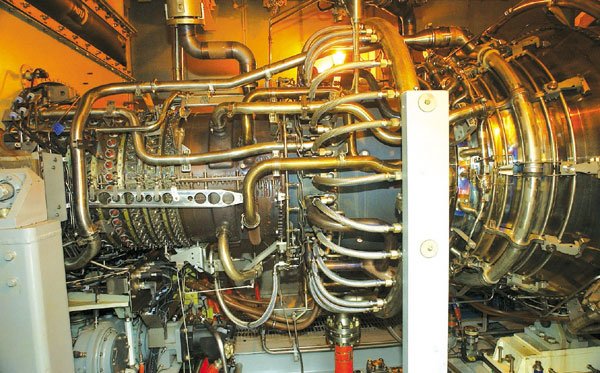Gilroy
– Business is slow at the Gilroy Energy Center nowadays. But no
worries – Gilroyans will not have to read by candlelight.
Hydroelectric plants are supplying the bulk of electricity
during the winter months, when snows and heavy rain translate into
a competitive advantage for energy plants that run on water,
according to workers at the Gilroy energy plant, off Highway
152.
Gilroy – Business is slow at the Gilroy Energy Center nowadays. But no worries – Gilroyans will not have to read by candlelight.
Hydroelectric plants are supplying the bulk of electricity during the winter months, when snows and heavy rain translate into a competitive advantage for energy plants that run on water, according to workers at the Gilroy energy plant, off Highway 152.
“Hydro plants can provide energy during the winter for virtually nothing,” said Plant Engineer Lance Null, one of several people who maintain the facility while awaiting energy prices to rise. “Market plants pretty much run when the market dictates.”
A rainy Tuesday this week meant the plant only had an auxiliary boiler running on its co-generation system, which supplies power to its neighbor Gilroy Foods. But the engineers and technicians kept a close eye on the stock ticker.
“Right now, it’s $60 per megawatt,” said Erik Price, operator and senior technician. He checked the price of gas and took out a calculator. Given gas prices and overhead costs, the plant would barely break even if they fired up the turbines, he said. For the moment, it’s simply cheaper to let the hydro-electric guys carry the load. In the drier heat of summer, the power plants will switch roles.
“It’s a love-hate relationship,” Price joked.
The Gilroy power plant’s operations are a mystery to most people. Some think it secretly supplies electricity to the city at a discount. Others suspect the city has a sweetheart deal that gives residents direct access to power, protecting them during blackouts or brownouts.
Null and Price explained that Gilroyans get their electricity the same way as everyone else – off the power grid controlled by PG&E. But before the energy giant can sell it, Gilroy Energy has to make it.
The plant has two electricity-production systems that, combined, can supply enough power to keep lights burning at more than 250,000 homes.
The plant doubled its production capacity in 2001 when Calpine, the public corporation that owns Gilroy Energy, installed three new generators to meet energy demand during the summer and other peak times. The units, known as a “peakers,” compress natural gas and air, and ignite the mixture to spin a turbine engine that powers an electricity generator.
“It’s the same engine they use on a 747,” Null explained. “But instead of using it on a plane, we strap it to a generator and make electricity.”
The Gilroy Energy Center peakers went on line in 2002 as part of a statewide response to rolling blackouts the previous year. The peakers take about 20 minutes to kick into gear, giving Gilroy Energy the ability to meet spikes in energy demand that would otherwise leave portions of the power grid with no energy.
“The energy grid is something that always has to be matching supply and demand almost perfectly,” said Ken Robertson, a Calpine spokesperson. The peakers are among 15 similar units Calpine has added throughout Northern California to meet that need.
The plant, which first opened up more than 20 years ago, also continues to operate its co-generator, or “cogen,” system.
The gas-powered turbine is five times the size of the 747-engine used in peakers – but it runs more efficiently. The cogen relies on the same combustion process used in the peakers, but it also siphons off the hot exhaust from the engine to boil water for a second, steam-powered generator. It takes five hours to start up the cogen system.
“The cogeneration plant is more efficient because you are getting power from what would otherwise be waste heat,” Plant Engineer Null explained. “The peakers can start and stop quicker – without having to boil water – and are therefore better suited to meeting times of peak demand, which may only last an hour or two.”
Both energy sources connect to transformers, which “step up” the electricity’s voltage so it can reach homes hundreds of miles away.
Gilroy Energy steps up its electricity to 115,000 volts and sends it to the LLagas substation, right behind Costco, according to Roger Morales, operations and maintenance manager. A portion of that energy gets stepped down to 21,000 volts and distributed to Gilroy, and the rest continues north to the Metcalf substation in south San Jose, just off U.S. Highway 101.
“That’s the main distribution center for the whole peninsula,” he said.
The average person gives little thought to how electricity ends up in their light bulb, until the room goes dark – like during the rolling blackouts in 2001.
But it’s simple enough, according to Null.
“Demand exceeded supply and there was a lot of congestion on the supply lines,” he explained. “There’s only so much power, and if demand exceeds supply, you have a blackout.
But don’t blame the guys who make the electricity.
“Once the power leaves our station, we’re not in control of it,” Null said. “It’s in PG&E land.”
Gilroy Energy LLC stats
• 1 megawatt powers 1,000 homes
• Three ‘peakers’ each generate 45
megawatts = 135 megawatts total
• Co-generator system generates 135 megawatts
• Total plant production = 270 megawatts
or 270,000 homes
• Operates about 50 percent of the year













